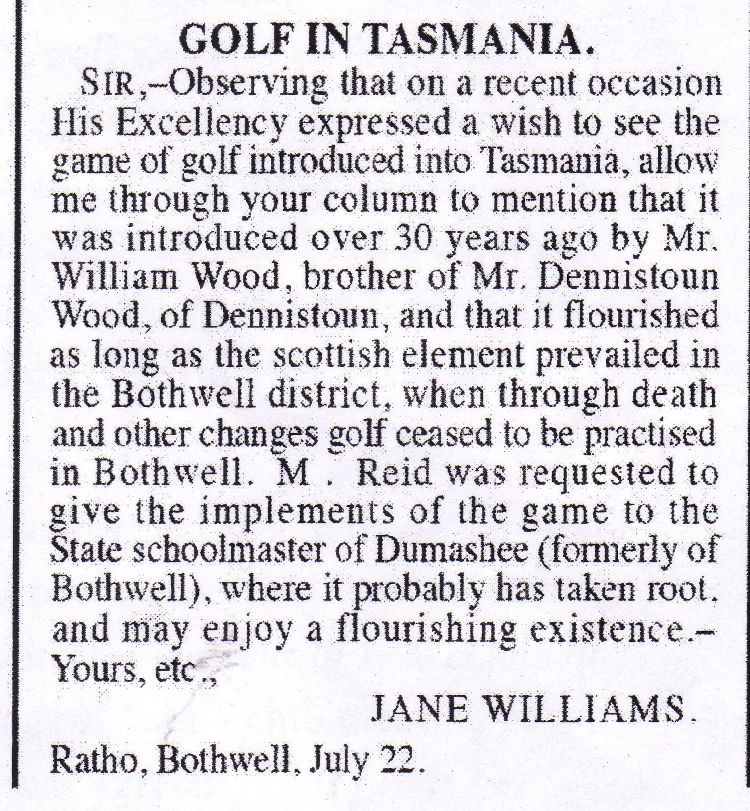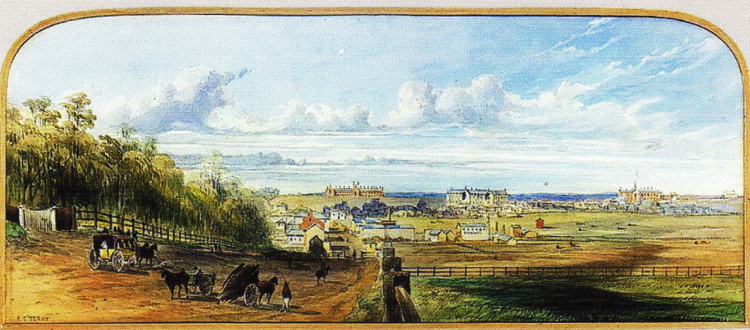When was golf first played in Australia?
By Dr Michael Sheret
To answer this question, historians look for good solid evidence. So far the best evidence is to be found in the diaries of Alexander Brodie Spark.
A.B. Spark was a wealthy merchant, an entrepreneur and a highly respected member of colonial society. His diaries are preserved in the Mitchell Library in Sydney. They record ten entries for golf played in 1839 from 25th May to 17th August at Grose Farm in Sydney. Historians regard the diary entries as primary source evidence, an original document written at the time of the event by a reliable eyewitness to the event.


Grazing livestock was kept on Grose Farm making it suitable ground for a rudimentary golf course. The land is now part of urban Sydney occupied by the University of Sydney, Royal Prince Alfred Hospital and Victoria Park.
The key figure in that short-lived phase of golf was Captain James Ferrier, master of the Lady Fitzherbert. The golf coincided with his enforced stay in Sydney waiting for a crew to take his ship back to London. Ferrier was an enthusiastic golfer and a prominent member of Royal Blackheath Golf Club in London. The most likely scenario is that he carried golf clubs and balls in his cabin and played golf whenever he was on land and could find suitable ground to play some golf.
Generally the oldest golf course and golf club generally refer to a course and club still active today. We can say that golf in Australia was first played in Australia on 25th May 1839. Grose Farm was the first golf course and the N.S. Wales Golf Club was the first golf club (no connection to the present NSW Golf Club formed in 1926).
Tasmanian golf history
There are widely believed claims that golf was played in Tasmania before 1839. The dates vary from 1822 to some time in the 1830s. There really is no evidence to support these claims. The History of Bothwell and its Early Settlers by Karl von Stieglitz, published in 1958, is often quoted as evidence. Von Stieglitz was a popular and prolific amateur historian, unfortunately not regarded as a reliable source by professional historians. He relied on information supplied to him by Alexander A Reid, the grandson of Alexander Reid who established Ratho Farm in Bothwell in 1822. When von Stieglitz’ book was published Alexander A Reid was ninety four years old. He recalled “seeing some very old-fashioned golf clubs and golf balls in the early seventies”, when he would have been between six and ten years old. Reid then went on to speculate about when the clubs might have been brought to Bothwell. Von Stieglitz further speculated that: “Probably the first golf in Australia was played on links at Ratho and the Logan flats during the 1830’s”.
Where can we find the best evidence for when golf was first played in Tasmania. The answer is to be found in a Hobart newspaper. The Mercury of 22nd July 1890 reported a meeting of the Caledonian Society, at which the Governor expressed a wish to see the Scottish game of golf introduced into Australia. In response Jane Williams wrote a letter to the editor on when golf was first played in Tasmania.

(Dumashee is a misspelling, later corrected, of Dunedin in New Zealand)
Who was Jane Williams of Ratho? She was the daughter of Alexander Reid, the pioneer who established Ratho Farm in 1822. She arrived in Bothwell when she was eight years old and lived nearly all her life at Ratho. She is a respected source of historical information about Bothwell. Her writings, journal and letters form a major part of the Clyde Company Papers, a very important reference source for historians of Bothwell. Jane (Reid) Williams would have witnessed the golf played at Dennistoun Estate in 1860 or slightly earlier. If golf had been played at an earlier date at Ratho, Jane would certainly have mentioned it her letter to The Mercury.
If readers would like to see in-depth research articles on golf at Grose Farm and early golf in Tasmania, the author can be contacted through the Australian Golf Heritage Society, museum@australiangolfheritage.org.au .
** Dr Michael Sheret is a member of the Australian Society for Sports History (ASSH) & Australian Golf Heritage Society (AGHS). He spent the bulk of his career working for UNESCO with excursions into academia. Since retirement his interests have turned to golf history. As well as the AGHS he is also a member of the British Golf Collectors Society.
Photo at top: Water Colour by Charles Frederick Terry, circa 1865. Original held in the Mitchell Library. The view is taken from the old toll gate on the Parramatta Road near Johnstons Creek, Annandale. Sydney University is in the centre on the skyline. The grass area directly in front of the University is part of Grose Farm.

